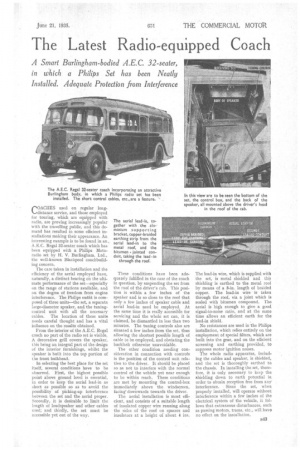The Latest Radio-equipped Coach
Page 57

If you've noticed an error in this article please click here to report it so we can fix it.
ROACHES used on regular long-.'distance service, and, those employed for touring, which are equipped with radio, are proving increasingly popular with the travelling public, and this demand has resulted in some efficient installations making their appearance. An interesting example is to be found in an., A.E.C. Regal 32-seater coach which has been equipped with a Philips Motoradio set by H. V. Burlingham, Ltd., the well-known Blackpool coachbuilding concern.
The care taken in installation and the efficiency of the aerial employed have, naturally, a distinct bearing on the ultimate performance of the set—especially on the range of stations available, and on the degree of freedom from engine interference. The Philips outfit is composed of three units—the set, a separate large-diameter speaker, and the tuningcontrol unit with all the necessary cables. The location of these units needs careful thought and has a vital influence on the results obtained.
From the interior of the A.E.C. Regal coach no part of the radio set is visible. A decorative grill covers the speaker, this being an integral part of the design of the interior furnishings, whilst the speaker is built into the top portion of the front bulkhead.
In selecting the hest place for the set itself, several conditions have to he observed. First, the highest possible point above ground level is essential, in order to keep the aerial lead-in as short aspossible SG as to avoid the possibility of picking-up interference between the set and the aerial proper. Secondly, it is desirable to limitthe length of loudspeaker and other cables used; and thirdly, the set must be accessible yet out of the way.
These conditions have been adequately fulfilled in the case of the coach in question, by suspending the set from the roof of the driver's cab. This position is within a .few inches of the speaker and is so close to the roof that only a few inches of speaker cable and aerial lead-in need be employed. At the same time it is really accessible for servicing and the whole set can, it is claimed, be dismantled in less than two minutes. The tuning controls also are situated a few inches from the set, thus allowing the shortest possible length of cable to be employed, and obviating the backlash otherwise unavoidable.
The other condition needing consideration in connection with controls is the position of the control unit relative to the driver. It should be placed so as not to interfere with the normal control of the vehicle yet near enough to be within reach. These conditions are met by mounting the control-box immediately above the windscreen, facing' downwards towards the driver.
The aerial installation is most efficient, and consists of a suitable length of insulated copper wire running along the sides of the roof on spacers and insulators at a height of about 4 ins. The lead-in wire, which is supplied with the set, is metal shielded and this shielding is earthed to the metal roof by means of a 3-in. length of braided copper.. The lead-in wire i5 taken through the roof,. via a joint which is sealed with bitumen compound. The aerial is high enough to give a good signal-to-noise ratio, and at the same time allows an efficient earth for the lead-in shield.
No resistances are used in'the Philips installation, which relies entirely on the employment of special filters, which are built into the gear, and on the efficient screening and earthing provided,, to suppress motor ignition noises.
The whole radio apparatus, including the cables and speaker, is shielded, and the set is thoroughly earthed to the chassis. In installing the set, therefore, it is only necessary to keep the shielding down to earth potential in order to obtain reception free from any interference. . Since the set, when properly installed, will operate without interference within a few inches of the electrical system of the vehicle, it follows that extraneous disturbances, such as passing motors, trams, etc., will have no effect on the installation.




























































































